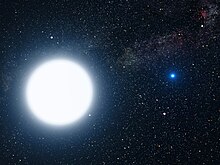A型主序星
A型主序星(AV星)或A矮星)是一颗主序星(燃烧氢的恒星),分类上属于光谱类型A和光度类别V(数字的五)。这类恒星的光谱由强氢巴耳末吸收线定义[1]。它们的质量在1.4 到 2.1太阳质量之间,表面的温度在7,600到10,000K之间。在附近的亮星例子为牛郎星(A7V),天狼星A(A1V)和织女星(A0V)。A型主序星没有对流层,因此预期不会有磁发电机。此外,由于它们没有强烈的恒星风,它们缺乏产生X射线发射。

光谱标准星
编辑| 光谱 类型 |
质量 (M☉) | 半径 (R☉) | 光度 (L☉) | 有效 温度 (K) |
色 指数 (B − V) |
|---|---|---|---|---|---|
| A0V | 2.18 | 2.193 | 38.02 | 9,700 | 0.00 |
| A1V | 2.05 | 2.136 | 30.90 | 9,300 | 0.04 |
| A2V | 1.98 | 2.117 | 23.99 | 8,800 | 0.07 |
| A3V | 1.93 | 1.861 | 16.98 | 8,600 | 0.10 |
| A4V | 1.88 | 1.794 | 13.49 | 8,250 | 0.14 |
| A5V | 1.86 | 1.785 | 12.30 | 8,100 | 0.16 |
| A6V | 1.83 | 1.775 | 11.22 | 7,910 | 0.19 |
| A7V | 1.81 | 1.750 | 10.00 | 7,760 | 0.21 |
| A8V | 1.77 | 1.747 | 9.12 | 7,590 | 0.25 |
| A9V | 1.75 | 1.747 | 8.32 | 7,400 | 0.27 |
修订后的耶基斯图集系统[7] 列出了A型光谱矮星标准恒星的密集网格,但并非所有这些恒星都作为标准幸存至今。A型主序矮星中MK光谱分类系统的“锚点”和“匕首标准”,即那些多年来保持不变并可以考虑定义该系统的标准恒星,是织女星(A0 V)、天玑(大熊座γ,A0 V)和北落师门(南鱼座α,A3 V)[8][9]。摩根(Morgan)和基南(Keenan)对MK分类的开创性回顾(1973)[9]没有在A3 V和F2 V类型之间提供任何匕首标准。HD 23886在1978年被建议为A5 V的标准[10]。
理查·格雷(Richard Gray)和罗伯特·加里森(Robert Garrison)在1987年和1989年的两篇论文中提供了对A矮星光谱序列的最新贡献[11][12]。他们列出了各种快速和缓慢旋转的A型矮星光谱标准,包括HD 45320(A1 V)、HD 88955(A2 V)、长蛇座2(A7 V)、小狮座21(A7 V)和鲸鱼座44(A9 V)。除了摩根的论文和格雷与加里森论文提供的MK标准外,人们偶尔也会看到狮子座δ(A4 V)被列为标准。没有公布的A6 V和A8 V标准星。
行星
编辑A型恒星很年轻(通常只有几亿年的历史),并且许多A型恒星发出的红外线(IR)辐射超出了预期值。这种红外过量可归因于能形成行星的岩屑盘尘埃发射[13]。 调查表明,大质量行星通常在A型恒星周围形成,然而这些行星很难使用多普勒光谱方法探测到。这是因为A型恒星通常旋转得非常快,因此谱线非常宽,使得很难量测由轨道上的行星引起的微量多普勒频移[14]。然而,这种类型的大质量恒星最终演化成一个更冷的红巨星,其自转速度较慢,因此可以使用迳向速度法进行测量[14]。截至2011年初,在演化的K巨星周围发现了大约30颗类木星行星,包括北河三(双子座β)、少卫增八(仙王座γ)和左枢(天龙座ι)。围绕各种恒星的多普勒调查表明,大约每6颗质量是太阳两倍的恒星中就有1颗被一颗或多颗木星大小的行星绕行着,而类太阳恒星的轨道上只有1/16[15]。
例子
编辑40光年以内:
| 名称 | 恒星 类型 |
星座 | vis Mag | 质量 (M☉) |
半径 (R☉) |
光度 (L☉) |
距离 (ly) |
|---|---|---|---|---|---|---|---|
| 天狼星 | A0mA1 Va | 大犬座 | −1.47 | 2.063 | 1.711 | 25.4 | 8.60 ± 0.04 |
| 牛郎星 | A7 V | 天鹰座 | 0.76 | 1.79 | 1.63–2.03 | 10.6 | 16.73 |
| 织女 | A0 Va | 天琴座 | 0.026 | 2.135 | 2.362 × 2.818 | 40.12 | 25.04 |
| 北落师门 | A3 V | 南鱼座 | 1.17 | 1.91 | 1.84 | 16 | 25.1 |
| 五帝座一 | A3 V | 狮子座 | 2.14 | 1.78 | 1.73 | 15 | 35.8 |
| 垒壁阵四 | A5 IV | 摩羯座 | 2.83 | 2.0 | 1.91 | 11 | 38.6 |
相关条目
编辑参考资料
编辑- ^ Stellar Spectral Types. hyperphysics.phy-astr.gsu.edu. [June 19, 2007]. (原始内容存档于2009-01-02).
- ^ Pecaut, Mark J.; Mamajek, Eric E. Intrinsic Colors, Temperatures, and Bolometric Corrections of Pre-main-sequence Stars. The Astrophysical Journal Supplement Series. 1 September 2013, 208 (1): 9. Bibcode:2013ApJS..208....9P. ISSN 0067-0049. S2CID 119308564. arXiv:1307.2657 . doi:10.1088/0067-0049/208/1/9.
- ^ Mamajek, Eric. A Modern Mean Dwarf Stellar Color and Effective Temperature Sequence. University of Rochester, Department of Physics and Astronomy. 2 March 2021 [5 July 2021]. (原始内容存档于2015-02-05).
- ^ Dale A. Ostlie; Bradley W. Carroll. An Introduction to Modern Stellar Astrophysics. Pearson Addison-Wesley. 2007. ISBN 978-0-8053-0348-3.
- ^ Habets, G. M. H. J.; Heintze, J. R. W. Empirical bolometric corrections for the main-sequence. Astronomy and Astrophysics Supplement Series. 1981, 46: 193. Bibcode:1981A&AS...46..193H.Tables VII, VIII
- ^ Schröder, C.; Schmitt, J. H. M. M. X-ray emission from A-type stars. Astronomy and Astrophysics. November 2007, 475 (2): 677–684. Bibcode:2007A&A...475..677S. doi:10.1051/0004-6361:20077429 .
- ^ Johnson, H. L.; Morgan, W. W. Fundamental stellar photometry for standards of spectral type on the Revised System of the Yerkes Spectral Atlas. The Astrophysical Journal. 1953, 117: 313. Bibcode:1953ApJ...117..313J. doi:10.1086/145697.
- ^ Robert F. Garrison. MK ANCHOR POINTS. [2022-01-05]. (原始内容存档于2019-06-25).
- ^ 9.0 9.1 Morgan, W. W.; Keenan, P. C. Spectral Classification. Annual Review of Astronomy and Astrophysics. 1973, 11: 29. Bibcode:1973ARA&A..11...29M. doi:10.1146/annurev.aa.11.090173.000333.
- ^ Morgan, W. W.; Abt, Helmut A.; Tapscott, J. W. Revised MK Spectral Atlas for stars earlier than the sun. 1978. Bibcode:1978rmsa.book.....M.
- ^ Gray, R. O.; Garrison, R. F. The Early A-Type Stars: Refined MK Classification, Confrontation with Stroemgren Photometry, and the Effects of Rotation. The Astrophysical Journal Supplement Series. 1987, 65: 581. Bibcode:1987ApJS...65..581G. doi:10.1086/191237.
- ^ Gray, R. O.; Garrison, R. F. The Late A-Type Stars: Refined MK Classification, Confrontation with Stroemgren Photometry, and the Effects of Rotation. The Astrophysical Journal Supplement Series. 1989, 70: 623. Bibcode:1989ApJS...70..623G. doi:10.1086/191349.
- ^ Song, Inseok; et al. M-Type Vega-like Stars. The Astronomical Journal. 2002, 124 (1): 514–518. Bibcode:2002AJ....124..514S. S2CID 3450920. arXiv:astro-ph/0204255 . doi:10.1086/341164.
- ^ 14.0 14.1 Johnson, John Asher; Fischer, Debra A.; Marcy, Geoffrey W.; Wright, Jason T.; Driscoll, Peter; Butler, R. Paul; Hekker, Saskia; Reffert, Sabine; Vogt, Steven S. Retired a Stars and Their Companions: Exoplanets Orbiting Three Intermediate‐Mass Subgiants. The Astrophysical Journal. 2007, 665: 785–793. S2CID 15076579. arXiv:0704.2455 . doi:10.1086/519677.
- ^ Johnson, J. A. The Stars that Host Planets. Sky & Telescope. 2011, (April): 22–27.
- ^ Smalley, J. B. Eclipsing Am binary systems in the SuperWASP survey. Astronomy and Astrophysics. 2014, (April): 20.